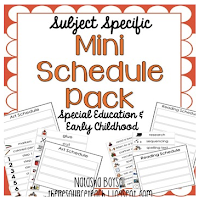Now that you have nailed down the job, gotten the keys to your classroom and shared the news with your family and friends it's time to get started. Here are a few tips to get you started in your first special education class (these are in no particular order).
Make sure to get your hands on student files ASAP. These files will help you get a better picture of your students. They should drive how you setup your classroom, organize your aides and let you know the types (if any) of visual supports they need.The files should also give you a little glimpse of their family life. This isn't always written into the IEP but check out the parent input section.
Take the time before school starts to meet the staff. Get around to as many people as you can. Take the extra time to introduce yourself to the secretaries, specials teachers and general education teachers who will have daily interactions with your students.
It is also imperative to setup a meeting with the para professionals that will be working in your classroom. Have a plan before going into this meeting. Make sure to share with them a little about yourself. It may also be a good idea to write down a list with them of things that worked well in years past and things that could use improvement. Use that list to help you slowly implement the things you want. To make a smooth transition it is always good to remember to make changes slowly. I usually make a detailed IEP at a Glance for my aides. It will also be a good idea to share how you plan to run your classroom and the expectations you have (possibly no cell phones, side conversations etc.). I like to write these down and post them in my classroom so they are available for everyone to see (even subs that may come into the classroom).
As a first year teacher this is probably the thing you are most excited about. You may have picked out a theme, bought bulletin board supplies and picked out cute matching bins. While all of these are great and may make you feel a little more at home they are not necessary. If you are not able to make these purchases no sweat. I will let you in on a little secret, I have never had a theme, matching bins or set up a bulletin board in my classroom. However, if you want to do those things please do....I just don't have time for that.
When I setup my classroom I keep 2 things in mind, my students and function. I think about what needs my students have (do they need a sensory space, are they eating lunch in my classroom, do I need room for wheelchairs/walkers etc.). Everything I put in my room serves a function. For example, I do not put a teacher desk in my room because it doesn't really serve a function for me other than a place for papers to pile up. Instead I use my direct teaching table as my desk.
Here is my 2015-16 classroom reveal post.
This is always my favorite thing. Instead of decorating my classroom with cute posters and matching bulletin boards I put functional visuals around my classroom. I create student schedules, classroom schedules, token boards etc. Here are a few of the visuals I have in my classroom.
Figure out the way that you are going to communicate with parents. Are you going to send emails, texts or give them a phone call? Are your students able to report to them what happened during the day or do you need to send home a daily note? Whatever you decide to do remember to give both positive and negative (if any) information. Also be honest and work with parents. Educating children with special needs takes a lot more than the time spent inside the classroom. My students send fill out this form daily. Grab it for free here.
Once your students have arrived and you have taught basic routines and gotten the classroom under control it is important to take baseline data. Assessing students before instruction will help you figure out exactly what area(s) they need direct instruction in. It will also let you know if some of your students can be grouped together. Here are a few things I use for baseline data.
The best advice I can give you is to take a breath. Even if you have everything planned out things won't always go as planned and guess what.....it's OKAY!!!! The important thing to remember is what are you going to do different the next time?
Also make sure to find time for yourself. Don't spend all of your extra time focusing on your classroom and students. You need to find balance. Somethings I like to do in my off time are take walks, go to the movies, watch Netflix and spend time with my family and friends.
Congrats on your new job and good luck with the school year!!!!
 Follow my blog with Bloglovin
Follow my blog with Bloglovin





















THANK YOU! This was so so so helpful. We start in about 3 weeks... I spent my summer in Asia so it is a crunch to get it all ready in time. Thanks for giving me permission to do something other than just prepare for school - I need that!
ReplyDeleteI am about to start my first year teaching students with severe/profound disabilities, and this was wonderfully helpful. Thank you so much for taking the time!
ReplyDelete